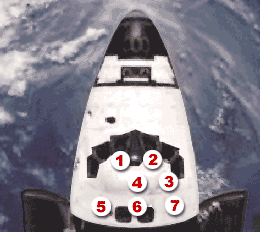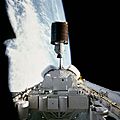STS-7 facts for kids
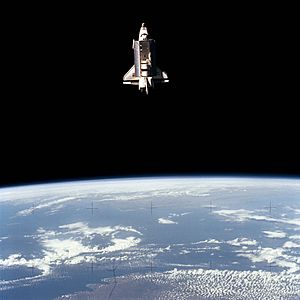
Challenger as photographed by the SPAS-1 satellite on 22 June 1983
|
|
| Names | Space Transportation System-7 |
|---|---|
| Mission type |
|
| Operator | NASA |
| Mission duration | 6 days, 2 hours, 23 minutes, 59 seconds (achieved) |
| Distance travelled | 3,570,000 km (2,220,000 mi) |
| Orbits completed | 97 |
| Spacecraft properties | |
| Spacecraft | Space Shuttle Challenger |
| Launch mass | 113,025 kg (249,177 lb) |
| Landing mass | 92,550 kg (204,040 lb) |
| Payload mass | 16,839 kg (37,124 lb) |
| Crew | |
| Crew size | 5 |
| Members |
|
| Start of mission | |
| Launch date | June 18, 1983, 11:33:00 UTC |
| Rocket | Space Shuttle Challenger |
| Launch site | Kennedy Space Center, LC-39A |
| Contractor | Rockwell International |
| End of mission | |
| Landing date | June 24, 1983, 13:56:59 UTC |
| Landing site | Edwards Air Force Base, Runway 15 |
| Orbital parameters | |
| Reference system | Geocentric orbit |
| Regime | Low Earth orbit |
| Perigee | 299 km (186 mi) |
| Apogee | 307 km (191 mi) |
| Inclination | 28.30° |
| Period | 90.60 minutes |
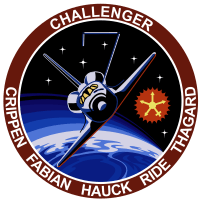 STS-7 mission patch 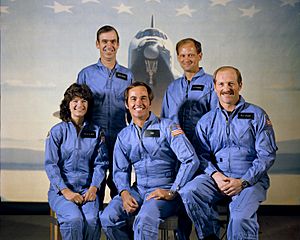 Ride, Fabian, Crippen, Thagard, Hauck |
|
STS-7 was the seventh Space Shuttle mission by NASA. It was also the second flight for the Space Shuttle Challenger. This mission was very important because it deployed several satellites into orbit. It also carried Sally Ride, who became the first American woman to travel into space. The Challenger launched from Kennedy Space Center on June 18, 1983. It landed at Edwards Air Force Base on June 24, 1983.
Contents
Meet the STS-7 Crew
The STS-7 mission had a crew of five astronauts. This was the largest crew to fly in a single spacecraft at that time.
| Position | Astronaut | |
|---|---|---|
| Commander | Robert Crippen Second spaceflight |
|
| Pilot | Frederick Hauck First spaceflight |
|
| Mission Specialist 1 | John M. Fabian First spaceflight |
|
| Mission Specialist 2 | Sally Ride First spaceflight |
|
| Mission Specialist 3 | Norman Thagard First spaceflight |
|
Who Supported the Crew?
A team of support astronauts helped the main crew. They were:
- John E. Blaha
- Roy D. Bridges Jr. (ascent CAPCOM)
- Guy Gardner
- Terry Hart
- Jon McBride
- Bryan D. O'Connor (entry CAPCOM)
Where Did They Sit?
The astronauts had specific seats for launch and landing.
| Seat | Launch | Landing | |
|---|---|---|---|
| S1 | Crippen | Crippen | |
| S2 | Hauck | Hauck | |
| S3 | Fabian | Fabian | |
| S4 | Ride | Ride | |
| S5 | Thagard | Thagard |
Mission Highlights
The STS-7 mission began on June 18, 1983. The Challenger lifted off right on time. This flight was historic for several reasons.
Firsts on This Mission
- It was the first time an American woman, Sally Ride, flew into space.
- It was the first time five astronauts flew together in one spacecraft.
- It was the first flight for astronauts from NASA's Group 8, chosen in 1978.
- President Ronald Reagan even sent his favorite Jelly Belly jelly beans into space with the crew. This made them the first jelly beans in space! The crew had also eaten lunch with the president at the White House before their launch.
Science and Experiments in Space
The crew had many tasks during their mission.
- Norman Thagard performed medical tests. He studied Space adaptation syndrome, which is like motion sickness astronauts can get in space.
- Two communications satellites were successfully launched. These were Anik C2 for Canada and Palapa B1 for Indonesia. Both were built by Hughes.
- The mission also carried the first Shuttle pallet satellite (SPAS-1). This satellite was built by a West German company.
- SPAS-1 was special because it could fly freely outside the shuttle. It was deployed by the Canadarm, a robotic arm.
- SPAS-1 carried 10 experiments. These experiments studied how metal alloys form in microgravity. They also looked at how heat pipes work and used instruments for remote sensing. A mass spectrometer identified gases in the shuttle's cargo bay.
- While SPAS-1 flew near Challenger, a camera on SPAS-1 took pictures of the shuttle. Later, the Canadarm grabbed SPAS-1 and put it back into the shuttle's cargo bay.
- STS-7 also carried seven Getaway Special (GAS) canisters. These held many different experiments.
- Another payload was OSTA-2, a science project from the U.S. and West Germany.
- For the first time, the shuttle's Ku-band antenna sent data through a U.S. tracking satellite (TDRS) to the ground.
Landing and Mission End
The STS-7 mission was supposed to land at the new Shuttle Landing Facility at Kennedy Space Center. However, bad weather forced a change. The Challenger landed at Edwards Air Force Base instead. The landing happened on June 24, 1983. The mission lasted for 6 days, 2 hours, 23 minutes, and 59 seconds. The shuttle traveled about 3.57 million kilometers (2.2 million miles) during 97 orbits around the Earth. Challenger was then flown back to Kennedy Space Center on June 29, 1983.
Mission Patch Symbolism
The mission patch for STS-7 has special meanings.
- The seven white stars in the black background show that this was the seventh mission in the Space Transportation System.
- The robotic arm extending from the orbiter is shaped like the number 7.
- The five-armed symbol on the right side represents the crew: four male astronauts and one female astronaut.
Wake-Up Calls from Space
NASA started a fun tradition of playing music to astronauts. This began during the Project Gemini missions. The first time music was used to wake up a crew was during Apollo 15. Each song is chosen carefully, often by the astronauts' families. The songs usually have a special meaning to an astronaut or relate to their daily activities.
| Flight Day | Song | Artist/Composer | Played for |
|---|---|---|---|
| Day 2 | "University of Texas Fight Song" | University of Texas band | Bob Crippen |
| Day 3 | "Tufts Tonia's Day" | The Tufts University Beelzebubs | Rick Hauck |
| Day 4 | "When You're Smiling" | ||
| Day 5 | "Washington State University Cougar Fight Song" | Washington State University Band | John Fabian |
| Day 6 | "Stanford Hymn" | Leland Stanford Junior University Marching Band | Sally Ride |
| Day 7 | "Florida State University Fight Song" | Florida State University Marching Chiefs. | Norm Thagard |
Images for kids
-
Window pit caused by impact of space debris
See also
 In Spanish: STS-7 para niños
In Spanish: STS-7 para niños


